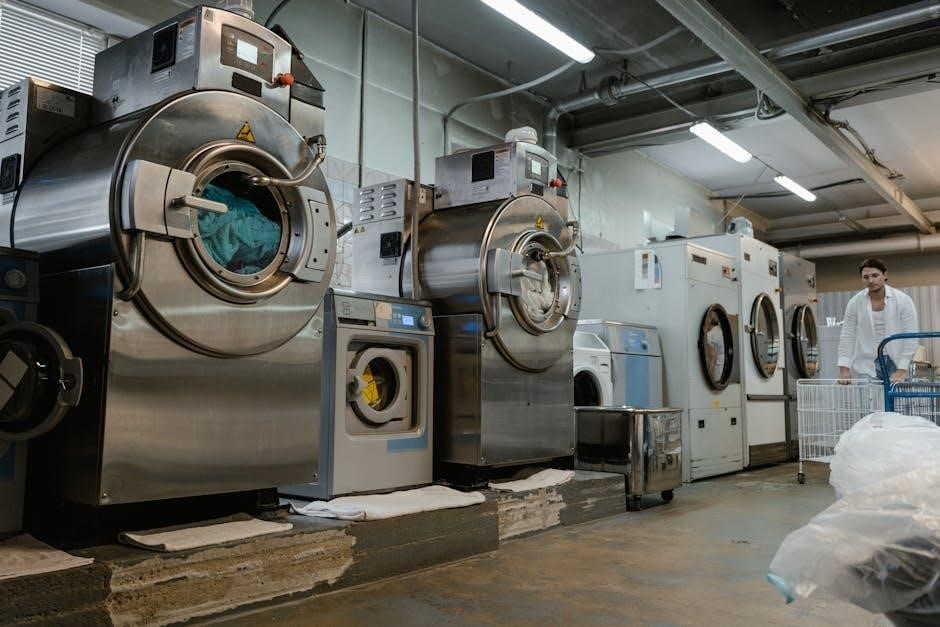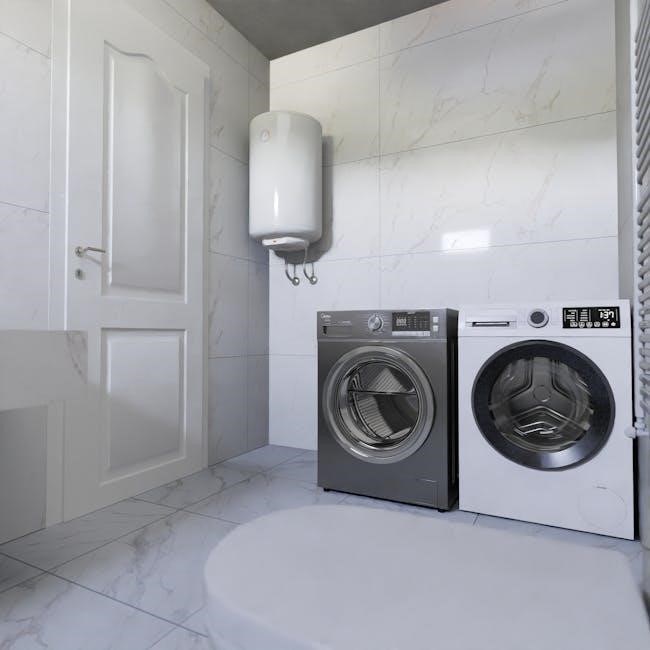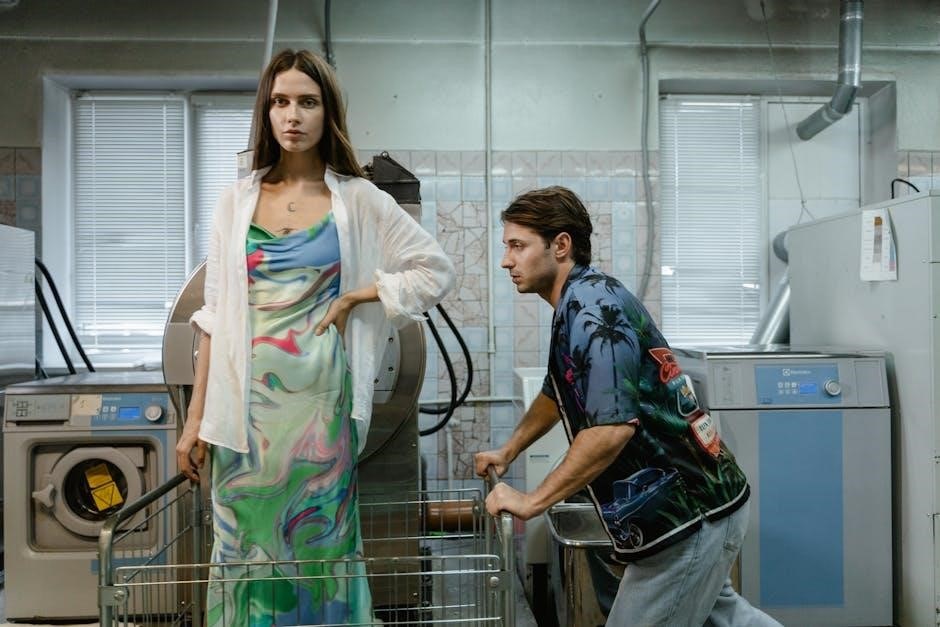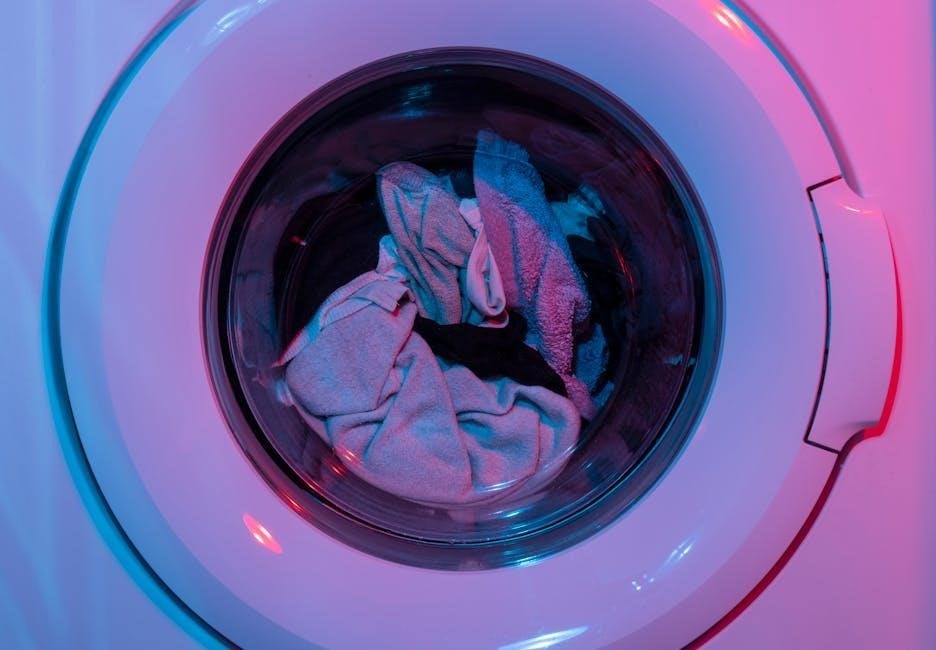Electrolux Washing Machine Not Starting
Your Electrolux washing machine may not start due to power supply issues, a locked door, or a faulty control board․ Always check the circuit breaker, ensure the door is closed tightly, and verify sensor functionality before seeking professional help․
1․1 Power Supply Issues
A tripped circuit breaker, blown fuse, or faulty outlet can prevent your Electrolux washer from starting․ Ensure the power cord is securely plugged in and check for any visible damage․ Power fluctuations, indicated by error codes like EH0, may also disrupt operation․ Reset the breaker or consult an electrician if issues persist․
1․2 Locked Door or Faulty Door Switch
If the door isn’t fully closed or the latch is faulty, the washing machine won’t start․ Check if the door is securely shut and ensure the door switch is functioning properly․ Error codes like E02 or E03 may indicate door-related issues․ Inspect the latch and switch for damage or misalignment and repair or replace as needed․
1․3 Faulty Control Board or Sensors
A malfunctioning control board or faulty sensors can prevent the washing machine from starting․ Check for error codes like EH0, which indicate sensor or power issues․ Inspect sensor connections and ensure they are functioning correctly․ If damaged, replacing the control board or sensors may resolve the issue․

Electrolux Washing Machine Not Draining
Your Electrolux washer may not drain due to a clogged drain hose, faulty pump, or blocked filter․ Check for blockages and ensure the drain pump is functioning properly․
2․1 Clogged Drain Hose
A clogged drain hose can prevent your Electrolux washer from draining․ Check for blockages like lint or small debris and ensure the hose isn’t kinked․ Regular cleaning and proper positioning can help avoid future issues․ Always inspect the drain hose first if draining problems occur․
2․2 Malfunctioning Drain Pump
A malfunctioning drain pump can prevent your Electrolux washer from draining properly․ Check for debris or damage in the pump and ensure it’s functioning․ If faulty, replace the pump․ Regular maintenance, like cleaning the pump filter, can help prevent such issues and ensure smooth operation․
2․3 Clogged Drain Filter
A clogged drain filter is a common issue, often caused by lint and debris buildup․ Regularly cleaning the filter can prevent drainage problems․ Locate the filter, remove any blockages, and rinse it thoroughly before reinstalling to ensure proper water flow and machine operation․

Electrolux Washing Machine Not Spinning
If your Electrolux washing machine isn’t spinning, it could be due to an imbalanced load, a worn or broken belt, or a faulty motor․ Check the load balance, inspect the belt for damage, and ensure the motor is functioning properly to resolve the issue․
3․1 Imbalanced Load
An imbalanced load can prevent proper spinning, causing vibrations․ Redistribute clothes evenly, ensuring a balanced weight distribution․ Avoid overloading and check for blockages in the drum or drain․ This helps maintain stability and ensures efficient spinning during cycles․
3․2 Worn or Broken Belt
A worn or broken belt can prevent the washing machine from spinning․ Inspect the belt for cracks or damage and ensure it is properly tightened․ If damaged, replace the belt to restore functionality․ This is a common issue that can cause loud noises or prevent the drum from rotating smoothly․
3․4 Faulty Motor or Motor Control Unit
A faulty motor or motor control unit can prevent the washing machine from spinning or operating․ Check for unusual noises, vibration, or failure to start․ Inspect the motor and control unit for damage or loose connections․ If damaged, replace the motor or control unit to restore proper function and ensure smooth operation․
Common Error Codes and Their Meanings
Electrolux error codes like E02 (door open), E03 (door unlocked), and EH0 (power fluctuation) indicate specific issues․ Refer to the user manual or manufacturer guidelines for precise troubleshooting and solutions to resolve these error codes effectively;
4․1 E02: Door Open Error
The E02 error indicates a door open issue․ Ensure the door is fully closed and latched․ Check for obstructions or a faulty door switch․ If the problem persists, consult the user manual or contact Electrolux support for further assistance to resolve this error effectively․
4․2 E03: Door Unlocked Error
The E03 error signals an unlocked door․ Ensure the door is securely closed and the latch is functioning properly․ If the issue persists, inspect the door switch or locking mechanism for damage or malfunction․ Resetting the machine or consulting a technician may be necessary to resolve this error effectively․
4․3 EH0: Power Supply Fluctuation
The EH0 error indicates a power supply fluctuation․ Check the circuit breaker or fuse box to ensure stable power․ Verify the machine is properly plugged in and the outlet is functioning․ Allow the power to stabilize, then restart the washer․ If issues persist, consult a professional technician for further assistance․

Electrolux Washing Machine Leaking Water
Leaks may stem from loose or damaged hose connections, a cracked drum, or worn seals․ Inspect and tighten connections, replace damaged parts, and ensure proper installation to resolve the issue effectively․
5․1 Damaged or Loose Hose Connections
Leaking water may result from damaged or loose hose connections․ Check for visible damage, cracks, or blockages in the hoses․ Ensure all connections are securely tightened and replace any damaged hoses promptly to prevent further water leakage during operation․
5․2 Cracked Drum or Tub
A cracked drum or tub can cause significant water leaks during operation․ Inspect the interior for visible cracks or damage․ If found, the drum or tub may need to be replaced, as repairs are typically not feasible for such structural damage․
5․3 Worn-out Seals or Gaskets
Worn-out seals or gaskets can cause water leaks during operation․ Inspect the door seal, drain pump, and hose connections for signs of wear or cracks․ Replace damaged seals promptly to prevent further water damage and maintain machine efficiency․

Electrolux Washing Machine Making Noise
Noise issues often arise from loose drum bearings, foreign objects in the drum, or an imbalanced load․ Check for obstructions and ensure proper installation to minimize vibrations and noise․
6․1 Loose or Worn-out Drum Bearings
Loose or worn-out drum bearings can cause loud grinding or rattling noises during operation․ Over time, bearings may deteriorate due to heavy use or poor lubrication․ Inspect and replace damaged bearings promptly to prevent further damage to the machine․ Professional repair is often recommended for this issue․
6․2 Foreign Objects in the Drum
Foreign objects like coins or buttons in the drum can cause loud noises during cycles․ Regularly check the drum and laundry pockets for debris․ Remove any items to prevent damage and ensure smooth operation․ This simple step can resolve many noise-related issues effectively․
6․3 Imbalanced or Damaged Drum
An imbalanced or damaged drum can cause excessive noise and vibration․ Ensure the machine is properly installed on a level surface and check for uneven loads․ If the drum is damaged, inspect for dents or cracks and replace it if necessary to restore stability and quiet operation․

Electrolux Washing Machine Not Filling with Water
If your Electrolux washing machine isn’t filling with water, check for faulty water inlet valves, clogged filters, or issues with the water supply lines․ Ensure all connections are secure and clean any blockages to restore proper water flow․
7․1 Faulty Water Inlet Valves
Faulty water inlet valves are a common cause of your Electrolux washing machine not filling with water․ Inspect the valves for blockages or mineral buildup․ Ensure they are fully open and functioning properly․ If damaged, replace the valves to restore water flow․ Always turn off the water supply before attempting repairs․
7․2 Clogged Water Inlet Filters
Clogged water inlet filters can prevent your Electrolux washing machine from filling with water․ Check and clean the filters regularly to remove debris or mineral buildup․ If severely clogged, replace the filters to ensure proper water flow․ Regular maintenance helps avoid this common issue and keeps your machine running efficiently․
7․3 Issues with Water Supply Lines
Electrolux washing machine water supply lines may cause filling issues if kinked, blocked, or leaking․ Check hoses for kinks, ensure they’re securely connected, and inspect for mineral buildup or damage․ Regularly cleaning or replacing the lines can prevent water flow problems and maintain proper machine function․

Electrolux Washing Machine Not Cleaning Properly
Improper cleaning may result from incorrect detergent dosage, a clogged dispenser, or faulty temperature sensors․ Ensure detergent is used as recommended and check for blockages or sensor malfunctions․
8․1 Incorrect Detergent Usage
Using too much or too little detergent can hinder cleaning performance․ Check the detergent dosage against the manufacturer’s guidelines for the load size․ Excess detergent can leave residue, while too little may not clean effectively․ Ensure you’re using the correct type of detergent for optimal results and machine functionality․
8․2 Clogged Detergent Dispenser
A clogged detergent dispenser can prevent proper detergent release, reducing cleaning effectiveness․ Regularly clean the dispenser by removing it and soaking it in warm water to remove residue or debris․ Ensure no foreign objects are blocking the dispenser channels for optimal performance and proper detergent distribution during cycles․
8․3 Faulty Water Temperature Sensors
Faulty water temperature sensors can disrupt washing cycles by misreading temperatures, leading to incorrect water heating or error codes․ Check sensor connections, ensure proper calibration, and replace the sensor if damaged․ This ensures accurate temperature control, preventing issues like overheating or underheating during wash cycles․

Electrolux Washing Machine Vibration Issues
Vibration issues often stem from improper installation, uneven surfaces, or worn-out anti-vibration pads․ Ensure the machine is level, check for balanced loads, and inspect the pads for wear․
9․1 Poor Machine Installation or Leveling
Ensure the washing machine is installed on a level surface using a spirit level․ If the machine is uneven, adjust the legs to balance it․ Poor installation can lead to excessive vibration, noise, and potential damage to internal components during operation․ Always follow manufacturer guidelines for proper setup and leveling․
9․2 Worn-out Anti-Vibration Pads
Worn-out anti-vibration pads can cause excessive machine vibration and noise; Inspect the pads for wear or damage and replace them if necessary․ Properly functioning pads ensure stability during operation, reducing noise and preventing potential damage to the machine or surrounding surfaces over time․
9․3 Imbalanced Drum or Load
An imbalanced drum or load can cause significant vibration and noise during operation․ This often occurs due to uneven laundry distribution or a misaligned drum․ Redistribute the load evenly, ensure the drum is properly aligned, and verify the machine is level to resolve the issue and prevent further damage or noise․

General Maintenance Tips
Regularly clean the drain filter, check for worn parts, and run cleaning cycles to maintain your Electrolux washing machine’s performance and prevent common issues from arising․
10․1 Regular Cleaning of the Drain Filter
Regularly clean the drain filter to prevent clogs and ensure proper water flow․ Remove the filter, rinse it under water, and reinstall to maintain optimal performance and avoid drainage issues in your Electrolux washing machine․
10․2 Checking and Replacing Worn Parts
Inspect belts, hoses, and door seals for wear․ Replace any damaged or worn components to prevent leaks, noise, or reduced performance․ Regularly checking and replacing parts ensures optimal functionality and extends the lifespan of your Electrolux washing machine․
10․3 Running Diagnostic or Cleaning Cycles
Run diagnostic or cleaning cycles to identify and resolve issues․ These cycles help detect faults, clean internal components, and maintain efficiency․ Regularly performing these cycles prevents odors, improves performance, and ensures optimal operation of your Electrolux washing machine․
